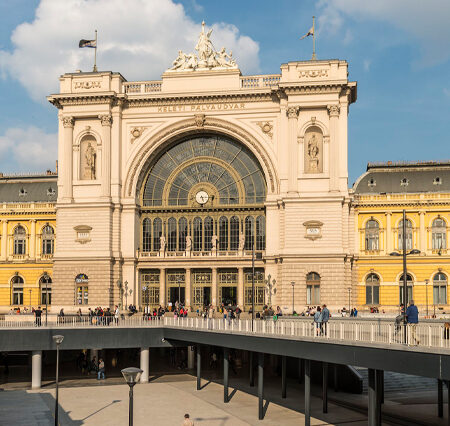Exploring Keleti Pályaudvar: Your Guide to Budapest’s Main Railway Station
Budapest Keleti Railway Station, known locally as Keleti Pályaudvar (meaning “Eastern Railway Station”), stands as the main international and inter-city railway terminal in Budapest, Hungary. More than just a busy transportation hub, Keleti is an architectural masterpiece, offering a grand welcome or farewell to those travelling by train. Its imposing structure and historical significance make it a landmark in its own right.
A Glimpse into History and Architecture
Opened in 1884, Keleti Pályaudvar was one of Europe’s most modern railway stations at the time. Designed by Gyula Rochlitz and János Feketeházy in an elegant Eclectic style, its grand facade stretches over 40 meters high. Key architectural highlights include:
- Impressive Facade: Adorned with statues of James Watt (inventor of the steam engine) and George Stephenson (pioneer of railways).
- Central Hall: A vast, ornate space with high ceilings and detailed decoration, evoking the golden age of rail travel.
- Frescoes: Look for frescoes by renowned Hungarian artists Károly Lotz and Mór Than within the station.
Despite updates and renovations over the years, the station retains much of its original grandeur, serving as a stunning example of 19th-century transport architecture.
Location and Excellent Connectivity
Keleti Pályaudvar is conveniently located on Baross Square (Baross tér) in Budapest’s 8th district (Józsefváros), on the Pest side of the Danube River. Its strategic location makes it exceptionally well-connected to the rest of the city via Budapest’s public transport network (BKK):
- Metro: The station is directly served by two metro lines: M2 (Red Line) and M4 (Green Line). The Keleti Pályaudvar metro station is situated beneath the railway station, providing rapid transit across the city.
- Buses and Trolleybuses: Numerous bus and trolleybus lines stop right outside the station, connecting it to various parts of Budapest.
- Trams: Tram lines also serve the vicinity of Baross Square, further expanding transport options.
Domestic and International Train Services
As Budapest’s primary railway station, Keleti handles the majority of international train services and many domestic routes. Major destinations include:
- International: Vienna, Bratislava, Prague, Berlin, Munich, Zurich, Warsaw, Bucharest, Belgrade, and many other European cities. Major operators like MÁV-START (Hungarian State Railways), ÖBB (Austrian Federal Railways), RegioJet, and EuroCity/EuroNight services operate from here.
- Domestic: Key Hungarian cities such as Debrecen, Miskolc, Eger, Szeged (often via Nyugati station transfers), and destinations towards the east and northeast of Hungary.
Station Facilities and Passenger Services
Keleti Railway Station offers a range of facilities to cater to travellers’ needs:
- Ticket Offices: Domestic and international ticket counters, as well as ticket vending machines.
- Information Desks: Assistance for train schedules and general inquiries.
- Waiting Areas: Seating areas for passengers.
- Luggage Services: Left luggage lockers and staffed luggage storage options.
- Food and Drink: Various cafes, bakeries, fast-food outlets, and small convenience stores.
- Other Amenities: Currency exchange (use with caution, rates may be less favourable than in the city), ATMs, restrooms (usually require a small fee), and some basic shops.
Navigating Keleti
While large, the station is relatively straightforward to navigate. Platforms (Vágány) are clearly numbered. Departure and arrival boards (both electronic and traditional) display train information. Allow ample time to find your platform, especially if you need to purchase tickets or use other facilities.
In conclusion, Budapest Keleti Railway Station is not merely a point of departure or arrival; it’s a vital part of Budapest’s infrastructure and history. Its stunning architecture combined with its crucial role in connecting Hungary domestically and internationally makes Keleti Pályaudvar a significant and often impressive first or last stop for visitors exploring the heart of Europe.


Comments